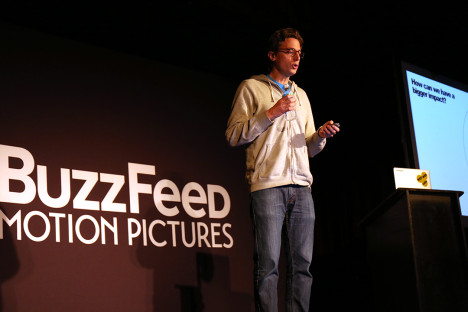Buzzfeed founder: ‘Publishers shouldn’t care where people watch their content’
The founder of Buzzfeed says publishers are too focused on social media as a driver of traffic to their own assets and are missing a bigger opportunity to reach mass audience within the platforms themselves.
At its Newfronts presentation on Monday Jonah Peretti unveiled Buzzfeed’s wider branded content video strategy, along with a new social web analysis tool POUND (Process for Optimizing and Understanding Network Diffusion), both of which are aimed growing the viral content site’s revenues globally.
“The video business has really showed us a pathway to change the way we think about media and becoming much more distributive as a company,” Peretti told a capacity room of media buyers and clients.
“So long as we can have scale and impact we don’t care where people are consuming their media.
“We have been thinking about how do we grow our scale and how do we grow our impact,” he said. “One of the big things that is really a theme for the industry and also for Buzzfeed has been ‘distributed media’. Thinking about how our media can go wherever people are.”
Peretti showed the room statistics from Buzzfeed’s own site which claimed it had 49m people a month click through from Facebook, 12.5m from Twitter and 60m from Pinterest. However, he noted that the total number of people who saw Buzzfeed content “instream” was much higher at 11bn impressions on Facebook, 1bn for Twitter and 6.4bn on Pinterest.
“If you can push media out to the edges then you can really reach potentially a much larger audience. Most publishers don’t think that way,” said Peretti.
“What they do is they populate that much larger universe… with links that point to their site. This is largely because the business model has been banner ads and that means you have to get people to your site.
“That was the only way you could monetise your content but with branded content that content can go everywhere. You don’t have to do the normal model of everyone clicking to the site.
“You can instead reverse it and say what if you take some of the content and take it out into the street.”
Peretti was also joined on stage by Buzzfeed publisher Dao Nguyen who unveiled Buzzfeed’s social analysis tool POUND, which she argued would be a powerful method for brands to better understand how content gets shared online.
“As Jonah was saying data is so important because it allows us to learn from our successes,” said Nguyen who argued most social web analysis only looked at direct referrals in traffic.
“What actually happens is that people are sharing other content that they find and then other people are finding it and sharing across multiple different social platforms, sometimes public platforms like Twitter and sometimes private platforms like messaging.
“POUND shows rather than a direct tree there is a cascade of sharing. Initial sharing at the top is actually the reason why everyone shares this content with you.
“Now what could you understand if you could understand this data and capture a higher social graph? Soon we will find out because POUND it is a propriety technology that allows us to understand and capture how Buzzfeed stories spread on the social web.”
 Buzzfeed also used the Newfronts presentation as an opportunity to showcase for advertisers and media agencies the power of their branded content video division Buzzfeed Motion Pictures, which it says is the fastest growing part of the social viral website.
Buzzfeed also used the Newfronts presentation as an opportunity to showcase for advertisers and media agencies the power of their branded content video division Buzzfeed Motion Pictures, which it says is the fastest growing part of the social viral website.
President of Buzzfeed Motion Pictures Ze Frank spoke about the power of online social video globally saying: “The big change is that we have started ‘leaning in’ to this idea of a ‘distributed model’ and that is an amazing thing when you are publishing to all these different platforms and they each have a different character that starts emerging and the challenge is to take that seriously.
“One of the big stories of this last year was autoplay on Facebook, but overall you are seeing the web coming into itself in this mobile era of video and it is pretty amazing the number of times you might watch something, even without the sound. You just forget to turn it on.
“Those kind of platforms shift and think about the internationalisation of media where almost 40-50 per cent of our content is viewed by international audiences. Post literalism becomes important and we are thinking about ways of making content where it isn’t word dependent so that it can move across borders really easily.”
Frank cited a number of examples of content for both editorial and for brands which had bridged global or cultural divides, including how a Buzzfeed writer became a celebrity in China after his phone was stolen and then recovered through social media.
https://www.youtube.com/watch?v=lxxIqavLzp4
“This is a perfect example,” said Frank. “This is a entire collaboration across our organisation where Matt Stopera had this incredible story happen to him where he eventually ended up in China, where is he a huge celebrity.
“We followed him with our own unscripted film crew to film a documentary about the experience.”
Nic Christensen in New York







But everyone should care about publishers that say they are serious news outlets and then delete stories because their advertisers ask them to.
http://tktk.gawker.com/buzzfee.....1697762873
User ID not verified.
As David Carr memorably said…
“Just a sec, time out. Before you ever went there, we’ve had reporters there reporting on genocide after genocide. Just because you put on a fucking safari helmet and looked at some poop doesn’t give you the right to insult what we do. So continue.”
User ID not verified.
@anon
I’m assuming you are referring to Newscorpse??
Placating, pacifying and endulging advertisers is a game as old as newspapers/ advertising itself. I’d go as far as to say it is the worlds oldest profession.
User ID not verified.
Probably also *indulge* advertisers.
Pls Mumbrella don’t put on the bloopers page.
User ID not verified.